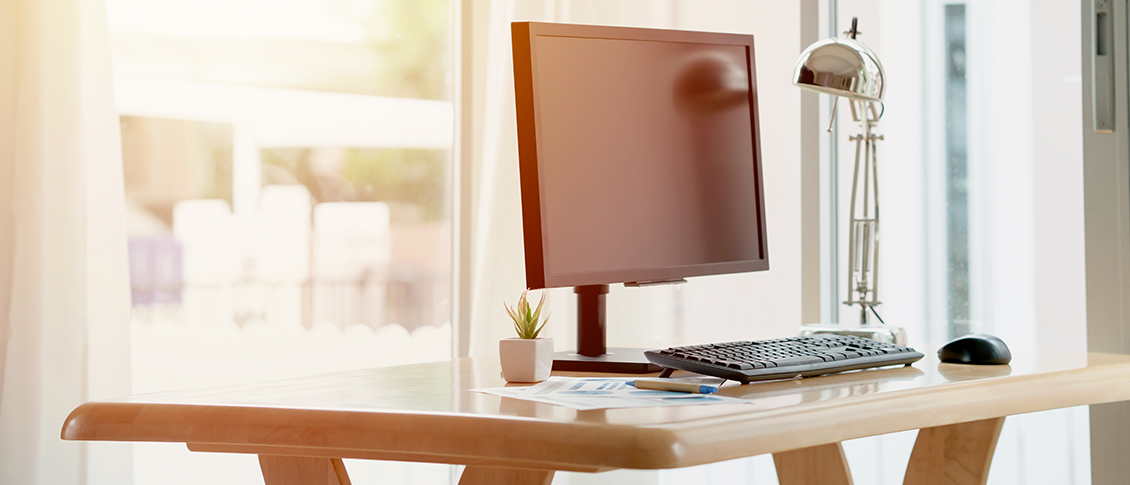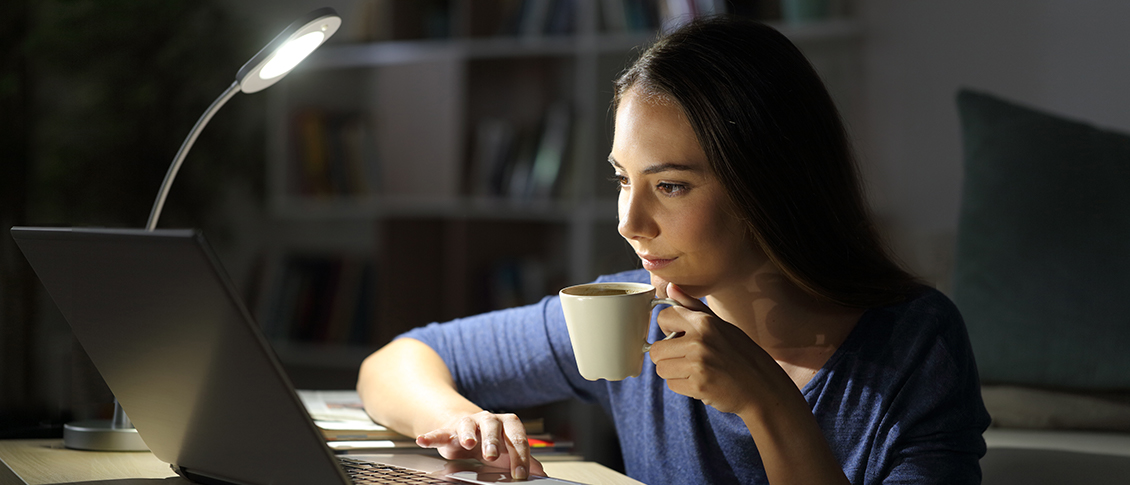What is the Best Home Office Lighting When Using a Computer?
15.03.2023

If you’re struggling with compromised vision or headaches at work, it could be related to your screen time. Whilst using your computer or laptop for hours at a time is likely part and parcel of your job, it can play havoc with your health. Taking regular breaks is important to avoid headaches working from home, but your home office lighting can also play a part.
Screen placement teamed with less than satisfactory office lighting can cause serious issues for workers. Poor quality lighting and screen glare can affect productivity and focus due to crippling headaches, migraines and blurred vision.
This article will help you position your screen correctly and distinguish lighting that is having a negative impact on your working day and how you can fix it.
How can I position my screen correctly?
Before considering lighting, let’s make sure you’re comfortable. Your workstation ergonomics will affect how you work and how productive and focused you can be. When your screen/s are positioned in the right place, you’ll find that you’re more likely to avoid headaches at work.
Your screen should be placed directly in front of you, around an arm’s length away. The top of the screen should sit on, or slightly below, your eye level. However, if you wear bifocals it’s best to lower this by one or two inches. Your screen should not be positioned next to any windows or harsh lighting. It’s also best to ensure that your monitor isn’t backlit.
You should use a monitor riser to help get your screen to the correct height for your eyeline. The Leitz Ergo WOW Adjustable Monitor Stand has two different height options for your monitor, so you can raise it to your specific requirements.
If you have a laptop, you should use a laptop stand to raise the screen to where it needs to be. The Leitz Adjustable Multi-Angle Laptop Stand has various height and angle combinations, so you can work continuously with your screen in the correct position for what you need, whatever you’re doing at the time.
When you use a laptop stand you will need to make sure you use a separate keyboard and computer mouse, so you don’t strain your wrists attempting to use the laptop.
Your office chair can also help you to view your screens correctly. You should raise or lower your chair to help keep the monitors at eye level. Remember that your feet should be flat on the floor while you work – a desk foot rest can help to keep your feet supported if you need to raise your chair higher.

Assessing your home office lighting
If you find yourself squinting or suffering from blurred vision and headaches working from home, you will need to eliminate problematic lighting sources. This can be as simple as closing a blind or turning an overhead light off.
Natural lighting is best for your home office. If possible, you should aim to put your work from home office in a room that gets plenty of natural light. If this isn’t possible, you should aim to add soft, indirect light sources around the room.
Depending on the ambient lighting in the room and outside, you may need to layer different types of light sources. So, you could let in natural light through the window, but also use a desk lamp when you need more focused light for a task. Or you may need to put the overhead light on during the day if you find there are shadows on your screen that are causing eye strain.
What can I do if sunshine is a problem?
We all love a warm, sunshine-drenched home office. However, issues can arise when sunlight hampers your ability to see your screen. Bright sunshine can be particularly troublesome as it creates harsh shadows and contrast on your screen. Furthermore, if rays are directly hitting your monitor, you will find screen glare unbearable.
If you want to continue embracing the sunlight in your home office, try adjusting your desk so the screens are angled away from the windows and direct sunlight. Just be aware that if your screen is heavily backlit it can put you at risk of a headache or migraine.
To save yourself an issue altogether, blinds, sheer curtains, and voile soften the intensity of sunrays whilst still letting natural light in.
What can I do if fluorescent lighting is agonising?
Fluorescent lighting is one of the biggest causes of headaches at work. Many people are sensitive to fluorescents because they contain invisible pulsing, which is a common migraine trigger. If you require overhead illumination in your home office opt for glare-free ambient lighting.
A simple solution is to replace the bulbs or fluorescent tubes of a current ceiling fixture. Even switching from a high-wattage bulb to a low-level version can really help improve your wellness when working from home.
If you currently have a multidirectional ceiling light installed in your home office, such as a spotlight system or track lighting, you may want to consider a different approach. These can concentrate light in specific spots and do not distribute evenly, which can be a problem.
Indirect light fixtures that hang from the ceiling are a great solution for home offices, as are globe or pendant ceiling lights. These options diffuse light evenly, eradicating any harshness associated with other ceiling light options.
Alternatively, you can forego ceiling lighting altogether and opt for lamps. This will give you more control over how much light is in the room and where the light is coming from.

What can I do to find the best computer desk lamp?
Lamps, also known as task lights, are an office dilemma many fail to get right. Not any old lamp will do if you want to work productively and headache free.
Whether you need to read documents regularly or are looking for a lighting solution that won’t affect your screen clarity, gooseneck lamps are essential. These simple lamps with a bendable shaft allow you to easily alter the direction of light. Furthermore, you can also pop in a low-glare bulb to take your task light to the next level.
For optimal placement, pop your lamp to the side of your monitor so it does not interrupt whatever is on the screen, but allows ample lighting for other tasks you are carrying out.
Choosing the right lighting option for your home office setup may not be as complex as you once thought. Comfort is key and it is worth remembering that each person’s preferences and needs are different.
It might take you a little while to determine the right light solution for you. However, just a simple lightbulb change can make all the difference. Experiment with your home office lighting and ergonomic set up until your find the perfect solution.
Leitz has a range of home office essentials so you can create a comfortable and productive working environment.
Read more about setting up your home office:
The Best Home Office Essentials You Need for 2023
How to Set Up a Home Office in a Bedroom
How to Identify and Fix Poor Ergonomics at Your Workstation